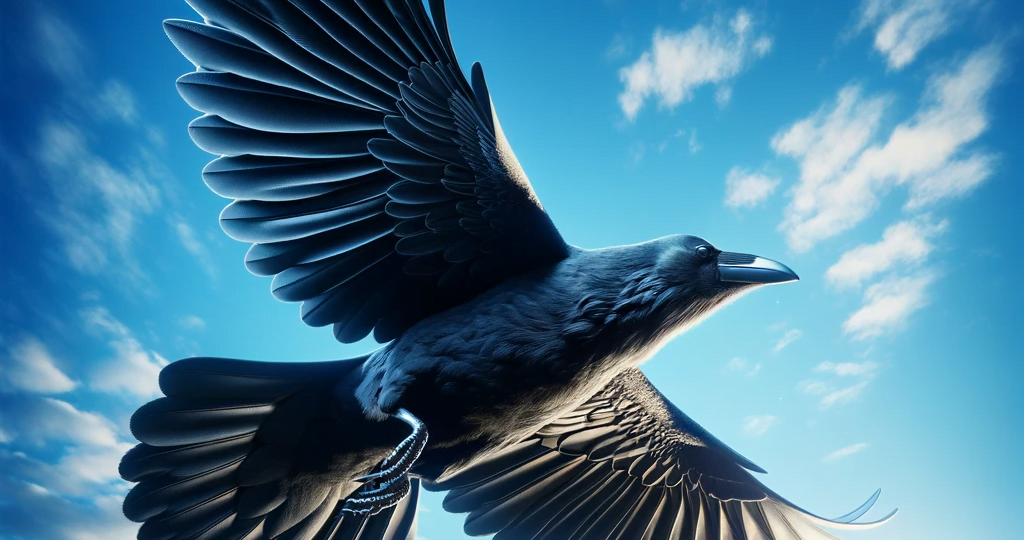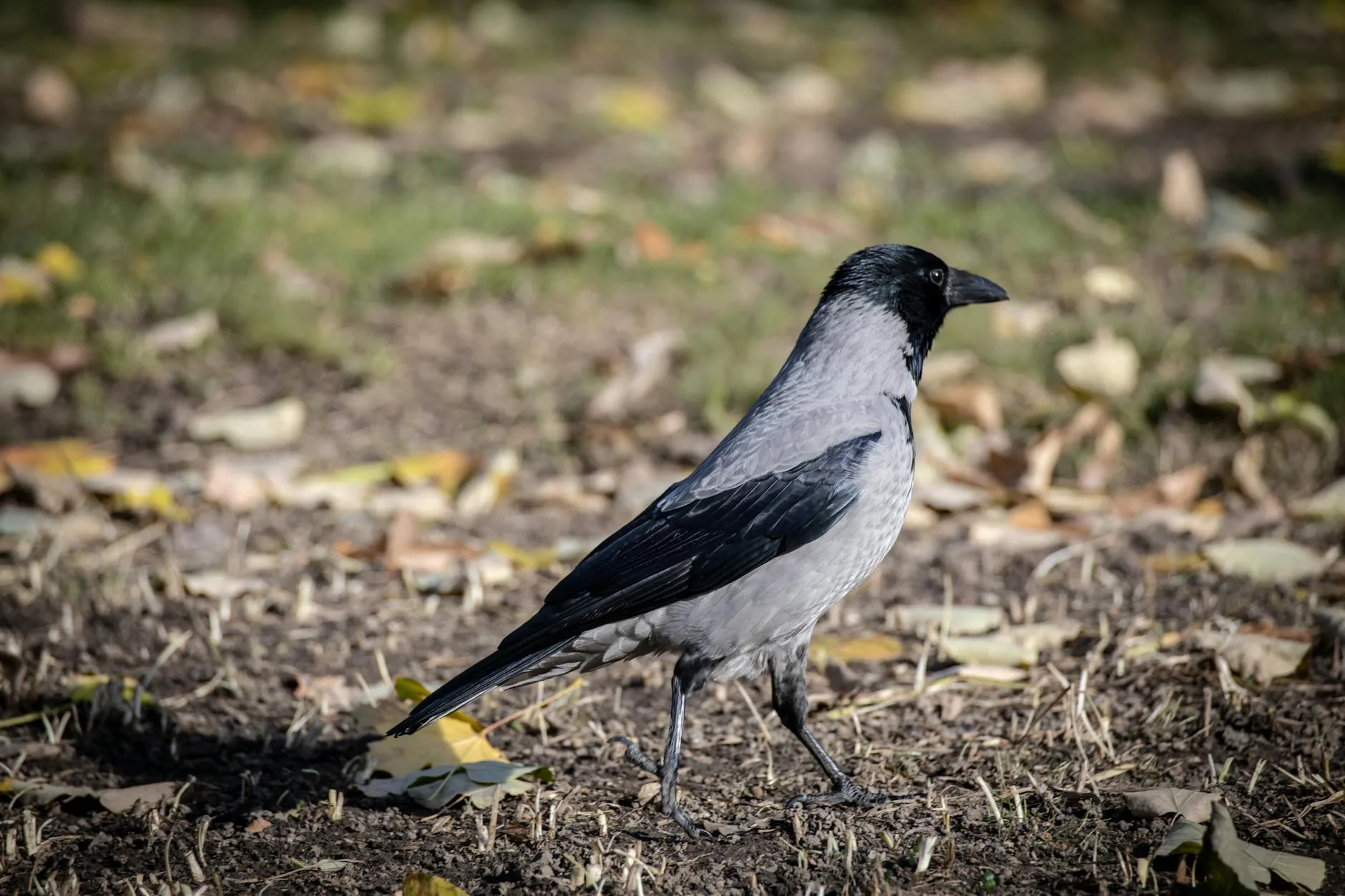The Enigmatic Corvus Cornix: Discovering the Hooded Crow
December 30, 2023 | by BlackCrow.com

The Hooded Crow: An Enigmatic Bird
The Hooded Crow (Corvus cornix linnaeus, 1758) is a fascinating and enigmatic bird that captures the attention of bird enthusiasts and researchers alike. This section will provide an introduction to the Hooded Crow, delve into its physical characteristics, and explore its distribution and habitat.
Introduction to the Hooded Crow
The Hooded Crow, also known as the Grey Crow, is a medium-sized member of the Corvidae family. It is closely related to other crow species, such as the Carrion Crow (Corvus corone linnaeus, 1758) and the Rook (Corvus frugilegus linnaeus, 1758) black crow. With its distinctive appearance and intelligent nature, the Hooded Crow has garnered interest from bird watchers and researchers worldwide.
Physical Characteristics of the Hooded Crow
The Hooded Crow displays a striking contrast of black and grey plumage. Its head, wings, and tail are predominantly black, while its body and underparts are a pale grey color. This stark coloration sets it apart from its close relative, the Carrion Crow, which has entirely black plumage. The beak of the Hooded Crow is sturdy and black, and its legs are also black in color.
Males and females of the Hooded Crow species can be difficult to distinguish visually, as they exhibit similar physical characteristics. However, behavioral cues and vocalizations can help differentiate between the sexes during courtship and breeding.
Distribution and Habitat
The Hooded Crow is primarily found in northern and eastern Europe, as well as parts of northern Africa. Its range extends from Ireland and the United Kingdom across continental Europe to the eastern regions of Russia. It also inhabits countries in the Middle East, such as Israel and Lebanon. The Hooded Crow is a migratory bird, with some populations traveling south during the winter months to escape harsh weather conditions.
In terms of habitat, the Hooded Crow is adaptable and can thrive in a variety of environments. It is commonly found in agricultural areas, woodlands, coastal regions, and urban landscapes. This adaptability allows the Hooded Crow to take advantage of diverse food sources and nesting opportunities. Understanding the distribution and habitat preferences of the Hooded Crow contributes to our knowledge of its behavior and ecological role.
As we delve deeper into the fascinating world of the Hooded Crow, we will explore its behavior, ecological importance, and intriguing cultural significance. Stay tuned for the upcoming sections of this article to unravel the mysteries surrounding this remarkable bird.
Behavior and Social Structure
Understanding the behavior and social structure of the hooded crow sheds light on its fascinating characteristics. This section explores the feeding habits, nesting and breeding behavior, as well as communication and interactions of this enigmatic bird.
Feeding Habits of the Hooded Crow
Hooded crows are opportunistic omnivores, displaying a diverse diet that includes both plant and animal matter. They are known to scavenge on carrion, insects, small mammals, eggs, and even other bird species’ nestlings. Additionally, they consume fruits, seeds, and agricultural crops, making them adaptable to various environments.
| Food Source | Examples |
|---|---|
| Animal Matter | Carrion, insects, small mammals, eggs |
| Plant Matter | Fruits, seeds, agricultural crops |
Nestling predation by hooded crows can sometimes cause conflicts with bird conservation efforts. However, their scavenging behavior also plays a vital role in the ecosystem by contributing to nutrient recycling and waste removal.
Nesting and Breeding
Hooded crows exhibit monogamous breeding behavior, forming long-term pair bonds. They build large, sturdy nests made of twigs, grass, and other materials in trees, cliffs, or even man-made structures. These nests are often located at heights to provide protection from predators.
The breeding season for hooded crows typically occurs between March and May. Females lay 3 to 6 eggs, which they incubate for about 18 to 21 days. Both parents participate in the incubation process and later share the responsibilities of feeding and caring for the hatchlings.
Communication and Interactions
Communication plays a crucial role in the social interactions of hooded crows. They use a variety of vocalizations to communicate with their flock members, including cawing, croaking, and clicking sounds. These vocalizations serve to establish territory, communicate danger, and maintain social cohesion within the group.
Hooded crows are highly social birds and often form large flocks, especially during the non-breeding season. Within these flocks, they engage in various social interactions, such as grooming, playful behaviors, and cooperative foraging. These interactions contribute to the cohesion and hierarchy within the flock.
Understanding the feeding habits, nesting and breeding behavior, as well as communication and interactions of the hooded crow provides valuable insights into its role within the avian community. By studying these behaviors, researchers can gain a deeper understanding of this enigmatic bird’s ecological significance and its impact on the environment.
The Hooded Crow’s Role in the Ecosystem
The Hooded Crow (Corvus cornix) plays a significant role in the ecosystem, impacting various aspects of its environment. Let’s explore the ecological importance of the Hooded Crow, its impact on agriculture and urban areas, as well as its conservation status and existing threats.
Ecological Importance
As an opportunistic omnivore, the Hooded Crow plays a crucial role in maintaining the balance of the ecosystem. Its diet consists of a wide range of food sources, including insects, small mammals, birds, eggs, fruits, and carrion. By feeding on various organisms, the Hooded Crow helps control populations of pests and scavenges on carrion, contributing to the decomposition process and nutrient recycling within the black crow ecosystem.
Additionally, the Hooded Crow may have indirect ecological benefits through its foraging behavior. While searching for food, it may disturb the soil, aiding in the dispersal of seeds and promoting plant growth.
Impact on Agriculture and Urban Areas
While the Hooded Crow’s foraging habits can be beneficial in natural environments, they can sometimes cause challenges in agricultural and urban areas. Hooded Crows have been known to feed on crops, such as grains and fruits, potentially leading to economic losses for farmers. In urban areas, they may scavenge through garbage or food waste, creating sanitation issues.
Efforts have been made to implement preventive measures, such as scare tactics or protective netting, to mitigate the impact of Hooded Crows on agricultural and urban spaces. However, it’s important to strike a balance between managing potential conflicts and recognizing the ecological role these birds play in the larger ecosystem.
Conservation Status and Threats
The Hooded Crow is generally considered a species of least concern in terms of conservation status. However, certain populations may face localized threats due to habitat loss, changes in land use, urbanization, and agricultural activities. These factors can impact the availability of suitable nesting sites and food sources for the Hooded Crow.
Climate change is another potential threat to the Hooded Crow and other blackcrow bird species. Alterations in temperature and precipitation patterns could affect the timing of breeding, migration, and availability of food resources.
Conservation efforts focused on preserving diverse habitats and maintaining ecological balance can contribute to the long-term survival and well-being of the Hooded Crow and other wildlife species.
Understanding the ecological importance of the Hooded Crow and the challenges it faces in different environments is essential for promoting coexistence and ensuring the health of both natural and human-made ecosystems.
Interesting Facts and Folklore
The hooded crow, also known by its scientific name Corvus cornix Linnaeus black crow, 1758, is a fascinating bird that has captured the attention of many cultures and folklore throughout history. Let’s explore some interesting facts and folklore surrounding this enigmatic bird.
Cultural Significance
The hooded crow holds cultural significance in various regions where it is found. In Celtic mythology, the crow is associated with intelligence, wit, and transformation.
Myths and Legends Surrounding the Hooded Crow
The hooded crow has been the subject of myths and legends across different cultures. In Norse mythology, the crow is often depicted with two hooded crows sitting on his shoulders, providing him with wisdom and knowledge. The presence of crows was believed to signify the presence of Odin himself.
In Scottish folklore, the hooded crow is associated with the “Cailleach,” a divine hag associated with winter and the changing seasons. The crow is seen as a companion of the Cailleach, accompanying her during her winter travels.
Lesser-Known Facts about the Hooded Crow
Here are some lesser-known facts about the hooded crow:
- Intelligence: The hooded crow is known for its intelligence and problem-solving abilities. It has been observed using tools to extract food and even utilizing traffic patterns to crack nuts by dropping them on roads for passing cars to break open.
- Social Behavior: Hooded crows are highly social birds and are often seen in large groups called “murders.” They engage in cooperative nesting and foraging, working together to protect their territory and find food.
- Distinctive Call: The hooded crow has a unique and recognizable call. It produces a loud, harsh “kaa-kaa” sound, which is often associated with its presence.
- Range and Habitat: The hooded crow is primarily found in northern and eastern Europe, as well as northern Africa. It prefers a variety of habitats, including forests, agricultural areas, coastal regions, and urban environments.
- Appearance: The hooded crow is distinguishable by its black crow plumage and distinctive gray “hood” covering its head and neck. It is slightly smaller than the closely related carrion crow, which has completely black plumage.
Understanding the cultural significance and folklore surrounding the hooded crow adds to our appreciation of this intriguing bird. Whether it’s being revered for its intelligence and wisdom or being part of ancient myths and legends, the hooded crow continues to captivate our imagination.
RELATED POSTS
View all


